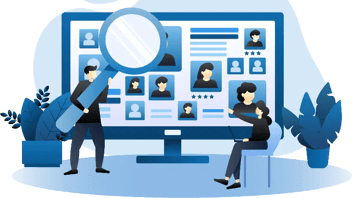How to Integrate Buyer Personas into Your Sales Process
Studies have shown that 71% of companies that exceed revenue and lead goals have documented buyer personas. However, many businesses still struggle with effectively incorporating these valuable insights into their sales strategies, leading to missed opportunities and inefficient resource use.
By aligning your sales strategies with a deep understanding of your ideal customer, you can achieve higher conversion rates, improve sales efficiency, and foster stronger customer relationships.
Understanding Your Buyer Personas
Before diving into the integration process, let's recap the essentials of buyer personas. A buyer persona is a semi-fictional representation of your ideal customer based on research and data about your existing and potential customers. They help you understand your target audience's demographics, behaviors, motivations, and goals, enabling you to tailor your marketing and sales efforts effectively.
Think of buyer personas as detailed profiles of the people you want to reach. They paint a picture of who your customers are, what they do, what keeps them up at night, and what they aspire to achieve. This information is crucial for crafting targeted messaging and creating a sales process that resonates with your audience.
Key elements of a well-developed buyer persona include:
-
Demographics: Age, gender, location, education, income, occupation, etc.
-
Psychographics: Lifestyle, interests, values, attitudes, and personality traits.
-
Pain points: Challenges, problems, or frustrations your target audience experiences.
-
Goals: Objectives, aspirations, or desired outcomes your audience wants to achieve.
-
Motivations: Factors that drive their decision-making process.
-
Buying behaviors: How they research, evaluate, and purchase products or services.
By understanding the key characteristics of buyer personas, you can tailor your sales approach to address the specific needs and preferences of your target audience, increasing your chances of success.
How to Integrate Buyer Personas Into Your Sales Process
Step 1: Sales Process Mapping
Before integrating buyer personas, it's crucial to have a clear understanding of your existing sales process. Sales process mapping involves visually outlining the steps involved in your sales cycle, from initial contact with a lead to closing the deal. This map serves as a blueprint, highlighting key touchpoints and interactions between your sales team and potential customers.
A typical sales process map might include stages like:
-
Prospecting: Identifying potential leads
-
Qualifying: Determining if leads are a good fit
-
Needs Analysis: Understanding the lead's requirements
-
Proposal/Presentation: Presenting your solution
-
Negotiation: Addressing objections and finalizing terms
-
Closing: Securing the deal
-
Follow-up: Post-sale support and relationship-building
By mapping your sales process, you gain a comprehensive view of how your sales team operates and can identify areas for improvement. Moreover, it allows you to see how buyer personas can influence each stage, enabling you to tailor your approach accordingly. For instance, if your persona research reveals that a particular buyer group prefers online communication, you can adjust your sales process to include more digital touchpoints.
Step 2: Aligning Personas with Sales Stages
Once you have a clear picture of your sales process, the next step is to align your buyer personas with each stage. This involves analyzing how different personas interact with your sales process and identifying opportunities to personalize the experience.
For example, during the "Needs Analysis" stage, a buyer persona focused on "value" might require a detailed cost-benefit analysis, while a persona driven by "innovation" might be more interested in the cutting-edge features of your product.
By understanding these nuances, you can tailor your sales strategies and messaging to resonate with specific personas at each stage. A practical example is using targeted email campaigns that speak directly to the pain points and motivations of different personas. A company selling software might send a case study highlighting efficiency gains to a value-driven persona while sending a product demo video showcasing innovative features to an innovation-driven persona.
Step 3: Content Personalization
Content plays a crucial role in nurturing leads throughout the sales funnel. By personalizing your content, you can provide valuable information that addresses the specific needs and interests of each buyer persona. This targeted approach helps build trust, establish credibility, and move leads closer to conversion.
Consider creating a variety of content formats tailored to different personas. For instance, blog posts, ebooks, and webinars can address the pain points and goals of specific buyer groups. Social media content can be customized to resonate with the preferred platforms and communication styles of different personas.
Step 4: Sales Team Enablement
Equipping your sales team with the knowledge and tools to leverage buyer personas is essential for successful integration. Sales representatives need to understand the different personas they are targeting and how to adapt their communication style and approach accordingly.
Provide your sales team with comprehensive training on buyer personas. This should include workshops, role-playing exercises, and access to persona documentation. Encourage them to use buyer persona insights in their sales conversations, presentations, and follow-up communications.
Technology can also play a significant role in persona-driven selling. CRM systems can be used to store and access buyer persona data, enabling sales representatives to personalize their interactions with each lead. Tools like sales intelligence platforms can provide valuable insights into the online behavior and preferences of different personas, helping sales teams tailor their outreach and engagement strategies.
Step 5: Measurement and Optimization
The final step in integrating buyer personas into your sales process is to measure and optimize your efforts. This involves tracking key metrics related to persona segmentation and analyzing the data to identify areas for improvement.
Monitor metrics such as conversion rates, deal size, and sales cycle length for each buyer persona. This will help you understand which personas are responding well to your sales strategies and where adjustments are needed.
For example, if you notice that a particular persona has a lower conversion rate than others, you can investigate the reasons behind it. Perhaps your messaging isn't resonating with their needs, or your sales process isn't aligned with their buying behaviors. By analyzing the data, you can make informed decisions to refine your approach and improve your overall sales performance.
The Benefits of Persona-Driven Sales
Integrating buyer personas into your sales process is not just a trendy tactic; it's a strategic move that yields tangible benefits. Let's explore how a persona-driven approach can positively impact your sales outcomes:
Improved Lead Generation
By understanding your ideal customer profiles, you can focus your marketing and sales efforts on attracting the right leads. Instead of casting a wide net and hoping for the best, you can target specific segments with tailored messaging and content that resonates with their needs and interests. This targeted approach results in higher-quality leads who are more likely to convert into paying customers.
For example, a company selling project management software could create separate landing pages and email campaigns for marketing teams and software development teams, highlighting the specific features and benefits relevant to each group. This focused strategy increases the chances of attracting qualified leads who are genuinely interested in the product.
Enhanced Sales Efficiency
A persona-driven approach streamlines the sales process by eliminating wasted efforts on unqualified leads. When your sales team understands the characteristics and motivations of their target personas, they can quickly identify which leads are a good fit and prioritize their efforts accordingly. This saves valuable time and resources, allowing your team to focus on nurturing relationships with leads who have a higher probability of conversion.
Additionally, by understanding the typical buying journey of each persona, your sales team can anticipate potential roadblocks and proactively address them, leading to a smoother and more efficient sales cycle.
Stronger Customer Relationships
Personalization is key to building trust and rapport with potential customers. When you tailor your communication and interactions to the specific needs and preferences of each buyer persona, you demonstrate that you understand their challenges and are committed to providing solutions that meet their unique requirements.
This personalized approach fosters a sense of connection and builds stronger relationships with your leads, increasing the likelihood of closing deals and creating long-term customer loyalty. For instance, addressing a lead by name, referencing their industry or company, and offering customized solutions based on their specific pain points can significantly enhance their experience and build trust in your brand.
Increased Revenue and ROI
Ultimately, the benefits of persona-driven sales translate into increased revenue and a higher return on investment (ROI). By attracting higher-quality leads, streamlining the sales process, and building stronger customer relationships, you create a more effective and efficient sales engine.
This leads to higher conversion rates, larger deal sizes, and shorter sales cycles, ultimately driving revenue growth and maximizing the return on your sales and marketing investments. Moreover, satisfied customers are more likely to become repeat customers and brand advocates, further contributing to your revenue stream and long-term business success.
Transform Your Sales Process: The Power of Buyer Personas
Integrating buyer personas into your sales process is a powerful strategy to enhance efficiency, improve conversion rates, and foster stronger customer relationships. By understanding your ideal customers and aligning your sales approach with their needs, you can create a targeted and personalized experience that drives results.
Ready to unlock the full potential of buyer personas in your sales process? Don't let your sales team wander aimlessly through the sales maze. Equip them with the knowledge and tools they need to connect with the right customers at the right time with the right message.
Need help getting started? Aspiration Marketing is here to help! Our team of experts can assist you with every step of the process, from developing detailed buyer personas to optimizing your sales strategies for maximum impact.
Let us help you transform your sales process and achieve your revenue goals!
This content is also available in:
- German: Wie Sie Buyer Personas in Ihren Verkaufsprozess integrieren
- Spanish: Cómo integrar al comprador persona en su proceso de ventas
- French: Comment intégrer les Buyer Personas dans votre processus de vente?
- Italian: Come integrare le Buyer Personas nel vostro processo di vendita
- Romanian: Cum să integrați Buyer Personas în procesul dumneavoastră de vânzări
- Chinese: 如何将 '买家角色' 融入销售流程











Leave a Comment